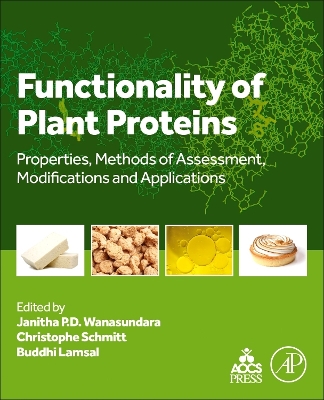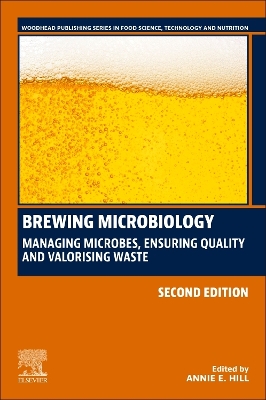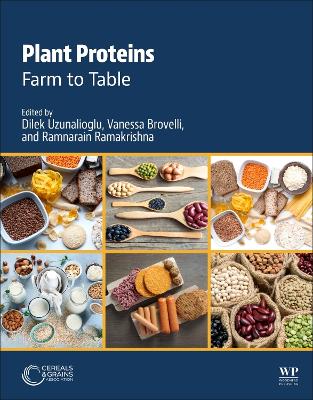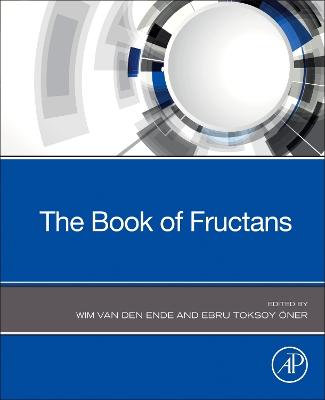Functionality of Plant Proteins
 -10%
portes grátis
-10%
portes grátis
Functionality of Plant Proteins
Properties, Methods of Assessment, Modifications and Applications
Schmitt, Christophe; Wanasundara, Janitha P.D.; Lamsal, Buddhi
Elsevier Science & Technology
06/2024
566
Mole
Inglês
9780323917216
15 a 20 dias
Descrição não disponível.
SECTION I. Proteins of plant sources and fundamentals of protein product development
1. Proteins of plant sources and fundamentals of protein product development
2. Processing of protein ingredients from plant sources
3. Functionality of plant proteins and importance of aggregation state
4. Probing structure-function relationship of proteins with molecular modeling
SECTION II. Methods of plant protein processing
5. Hydrodynamic properties I: Protein-water interactions; solubility, wettability, dispersibility, water binding/adsorption
6. Hydrodynamic properties II: Protein-water-Protein interaction; Viscosity and Gelation
7. The interfacial activity of plant proteins: theory, assessment and application in emulsion development
8. Hydrophobic/hydrophilic surface activity II: Foaming properties (air/water interface stabilization)
9. Hydrophobic/hydrophilic surface activity III: Interactions with other micro- and macro- molecules
10. Protein complexation with carbohydrates and lipids
11. Nutritional properties: Protein quality assessment parameters and methods
SECTION III. Functionality of proteins
12. Enzymatic modification of plant proteins: influence on functional properties, allergenicity, and bioactivity
13. Physical modification
SECTION IV. Protein functionality in food applications
14. Plant proteins for dry extruded products
15. Plant proteins for meat analogues
16. Plant proteins for dairy analogues
SECTION V. Challenges for plant-based protein ingredients and future path
17. Allergenicity of plant proteins
18. Anti-nutritional factors (ANFs) in protein-rich plant products: Chemistry, occurrence, nutritional implications, and their analysis
19. Challenges of plant protein processing and protein ingredient functionality assessment
1. Proteins of plant sources and fundamentals of protein product development
2. Processing of protein ingredients from plant sources
3. Functionality of plant proteins and importance of aggregation state
4. Probing structure-function relationship of proteins with molecular modeling
SECTION II. Methods of plant protein processing
5. Hydrodynamic properties I: Protein-water interactions; solubility, wettability, dispersibility, water binding/adsorption
6. Hydrodynamic properties II: Protein-water-Protein interaction; Viscosity and Gelation
7. The interfacial activity of plant proteins: theory, assessment and application in emulsion development
8. Hydrophobic/hydrophilic surface activity II: Foaming properties (air/water interface stabilization)
9. Hydrophobic/hydrophilic surface activity III: Interactions with other micro- and macro- molecules
10. Protein complexation with carbohydrates and lipids
11. Nutritional properties: Protein quality assessment parameters and methods
SECTION III. Functionality of proteins
12. Enzymatic modification of plant proteins: influence on functional properties, allergenicity, and bioactivity
13. Physical modification
SECTION IV. Protein functionality in food applications
14. Plant proteins for dry extruded products
15. Plant proteins for meat analogues
16. Plant proteins for dairy analogues
SECTION V. Challenges for plant-based protein ingredients and future path
17. Allergenicity of plant proteins
18. Anti-nutritional factors (ANFs) in protein-rich plant products: Chemistry, occurrence, nutritional implications, and their analysis
19. Challenges of plant protein processing and protein ingredient functionality assessment
Este título pertence ao(s) assunto(s) indicados(s). Para ver outros títulos clique no assunto desejado.
Protein molecule; phyico-chemical property relationship; model systems in vitro; surface properties; foaming; emulsification; gelation; colour; adhesion and cohesion; extrudability; hydrolysis; cross-linking; pressure force; shear force; esterification; acylation; glycation; phosphorylation; plant protein; meat protein
SECTION I. Proteins of plant sources and fundamentals of protein product development
1. Proteins of plant sources and fundamentals of protein product development
2. Processing of protein ingredients from plant sources
3. Functionality of plant proteins and importance of aggregation state
4. Probing structure-function relationship of proteins with molecular modeling
SECTION II. Methods of plant protein processing
5. Hydrodynamic properties I: Protein-water interactions; solubility, wettability, dispersibility, water binding/adsorption
6. Hydrodynamic properties II: Protein-water-Protein interaction; Viscosity and Gelation
7. The interfacial activity of plant proteins: theory, assessment and application in emulsion development
8. Hydrophobic/hydrophilic surface activity II: Foaming properties (air/water interface stabilization)
9. Hydrophobic/hydrophilic surface activity III: Interactions with other micro- and macro- molecules
10. Protein complexation with carbohydrates and lipids
11. Nutritional properties: Protein quality assessment parameters and methods
SECTION III. Functionality of proteins
12. Enzymatic modification of plant proteins: influence on functional properties, allergenicity, and bioactivity
13. Physical modification
SECTION IV. Protein functionality in food applications
14. Plant proteins for dry extruded products
15. Plant proteins for meat analogues
16. Plant proteins for dairy analogues
SECTION V. Challenges for plant-based protein ingredients and future path
17. Allergenicity of plant proteins
18. Anti-nutritional factors (ANFs) in protein-rich plant products: Chemistry, occurrence, nutritional implications, and their analysis
19. Challenges of plant protein processing and protein ingredient functionality assessment
1. Proteins of plant sources and fundamentals of protein product development
2. Processing of protein ingredients from plant sources
3. Functionality of plant proteins and importance of aggregation state
4. Probing structure-function relationship of proteins with molecular modeling
SECTION II. Methods of plant protein processing
5. Hydrodynamic properties I: Protein-water interactions; solubility, wettability, dispersibility, water binding/adsorption
6. Hydrodynamic properties II: Protein-water-Protein interaction; Viscosity and Gelation
7. The interfacial activity of plant proteins: theory, assessment and application in emulsion development
8. Hydrophobic/hydrophilic surface activity II: Foaming properties (air/water interface stabilization)
9. Hydrophobic/hydrophilic surface activity III: Interactions with other micro- and macro- molecules
10. Protein complexation with carbohydrates and lipids
11. Nutritional properties: Protein quality assessment parameters and methods
SECTION III. Functionality of proteins
12. Enzymatic modification of plant proteins: influence on functional properties, allergenicity, and bioactivity
13. Physical modification
SECTION IV. Protein functionality in food applications
14. Plant proteins for dry extruded products
15. Plant proteins for meat analogues
16. Plant proteins for dairy analogues
SECTION V. Challenges for plant-based protein ingredients and future path
17. Allergenicity of plant proteins
18. Anti-nutritional factors (ANFs) in protein-rich plant products: Chemistry, occurrence, nutritional implications, and their analysis
19. Challenges of plant protein processing and protein ingredient functionality assessment
Este título pertence ao(s) assunto(s) indicados(s). Para ver outros títulos clique no assunto desejado.
Protein molecule; phyico-chemical property relationship; model systems in vitro; surface properties; foaming; emulsification; gelation; colour; adhesion and cohesion; extrudability; hydrolysis; cross-linking; pressure force; shear force; esterification; acylation; glycation; phosphorylation; plant protein; meat protein







